 A train of springtime tourists travel through blooming tea plantations in Longyan, Fujian province. (ZHU HAIPENG / FOR CHINA DAILY)
A train of springtime tourists travel through blooming tea plantations in Longyan, Fujian province. (ZHU HAIPENG / FOR CHINA DAILY)
Period of hibernation ends as signs of life emerge once more to greet the coming year, Zhang Lei reports.
Lichun, or Start of Spring, is the first of the traditional Twenty-Four Solar Terms, encompassing the beginning of all things, rebirth and heralding a new cycle.
Shuowen Jiezi offers an explanation of Chinese characters and words written during the Eastern Han Dynasty (25-220), and is considered one of the earliest dictionaries in the world. The classic text denotes that chun (spring), is originally a verb that embodies the meaning of "sprout".
The explanatory notes conjure up a lively annotation of the word: The grass feels the call of the sun, vibrates in response to the time, pushes the earth away, and starts to grow.
ALSO READ: Festive fun
Lichun falls on Saturday this year, and was the namesake Spring Festival in ancient times. The first day of the Lunar New Year was called "yuanri (the starting day)", or "New Year's Day". After China adopted the Gregorian calendar in the early 1900s, the term "New Year's Day" was assigned to Jan 1, and "Spring Festival" was given to the first day of the Lunar New Year.
Despite being robbed of the grand Spring Festival title, lichun, a product of an ancient farming civilization, takes on an extremely important role in the foundation of China's traditional culture.
The first solar term has an intimidatingly long, swirling list of confusing nicknames: yingchun (greeting spring), songchun (sending spring), dachun (beating spring), yaochun (biting spring), tachun (outing in spring) and taochun (begging for spring). The different verbs in front of the word chun all reveal the joy and eagerness for the arrival of spring.
"I have never seen a solar term with so many descriptions as lichun. It is almost like a chorus of spring symphony," says folklore expert You Guoqing.
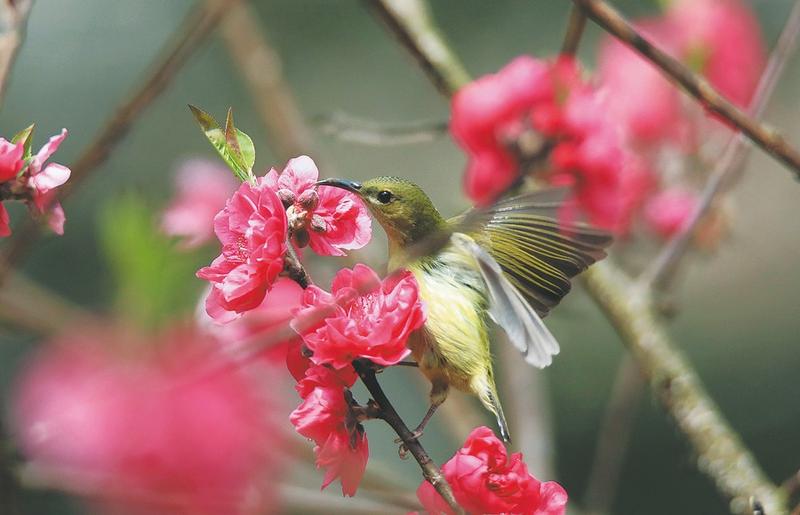 Peach trees in full bloom in Liuzhou, Guangxi province. (PHOTO / CHINA DAILY)
Peach trees in full bloom in Liuzhou, Guangxi province. (PHOTO / CHINA DAILY)
Forms of celebration
Spring greeting rituals were often held by the imperial court to express gratitude to the celestial gods, You says.
The kings of the Western Zhou Dynasty (c.11th century-771 BC) had to fast three days before lichun. On the very day, the king personally led the entire court to the eastern suburbs to welcome the spring, praying for a year of good weather and a bountiful harvest.
In the spring greeting ceremony, the official representatives had to worship mangshen first, and then symbolically beat the "spring cow" (usually made of bamboo and paper paste) with a whip, which showed that the officials and the people were diligent in their farming
During the Qing Dynasty (1644–1911), the ceremony evolved into an important folk activity participated in by everyone. The forms of celebration were simple and interesting, such as wearing gorgeous flower-shaped headdresses, and hanging spring banners cut in the shape of the two Chinese characters yichun (comforting spring). The latter is believed to be the origin of the spring couplets.
ALSO READ: Ethnic village in South China finds prosperity in tourism
A few days before lichun, baochun (announcing spring) is essential. Young men dispatched by the local government would hold small gongs, beat them while singing the praises of spring, and send a picture of a "spring cow" to every door. They were given a few small coins as a gift.
The ritual worked in ancient times as a special notice to start spring plowing. When the "spring officials" arrived, scholars, farmers, laborers or businessmen all had to bow to them. When making the announcement in shops, the officials were entitled to any goods and food at will. Instead of chasing them away, the shopkeepers greeted them with smiles.
It gets even more interesting when it comes to the custom of "beating spring" and the "spring cow" drawing.
Mangshen is the god of vegetation and represents the god in charge of agriculture, while cattle are animal labor for plowing the fields.
In the spring greeting ceremony, the official representatives had to worship mangshen first, and then symbolically beat the "spring cow" (usually made of bamboo and paper paste) with a whip, which showed that the officials and the people were diligent in their farming. After the whipping, people would rush forward to tear off a small piece of the "cow". It is said that burying it in their fields would lead to a good harvest.
READ MORE: Panda cubs make debut to mark start of spring
The ceremony, which had been practiced for more than a thousand years, ended with China's imperial reign, but the combination of mangshen and the "spring cow" have been preserved to this day in the form of drawings.
There is always a "spring cow" picture attached to a peasant calendar if you buy one in rural regions, in which the figure of mangshen and the relative position of the spring cow are drawn in different ways according to the year's zodiac and the corresponding five elements, a Chinese philosophy used to describe interactions and relationships between things.
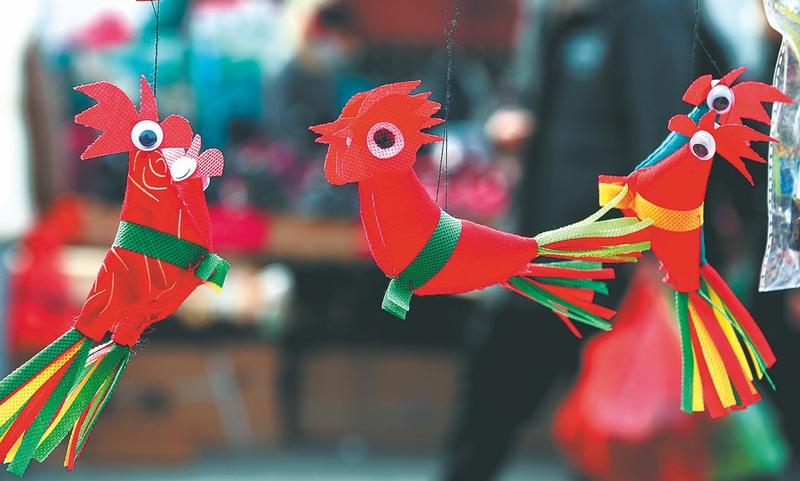 Cloth decorations, in the shape of roosters, are made and sold in early spring in southern Shandong province. (PHOTO / CHINA DAILY)
Cloth decorations, in the shape of roosters, are made and sold in early spring in southern Shandong province. (PHOTO / CHINA DAILY)
The conversion rules for forecasting the climate and harvest of the year are extremely complicated. A brief example is as follows: The relative positions of the spring cow and mangshen represent the order of the Spring Festival and lichun in that year. For example, if lichun is before the Chinese New Year, the god will stand behind the cow.
The god has different appearances such as a child, young adult, or old man based on his age, calculated on Heavenly Stems and Earthly Branches, a complex calendrical system which was created to codify the patterns of life and of the universe itself.
Since the general climate and the five elements are different from year to year, theoretically, the shape of the spring cow map should be different every year.
However, the calculation is not a field of knowledge in which everyone is well versed, so average folks have their own simplified cognitive pattern: Mangshen's clothing thus invites room for interpretation. If he wears a bamboo hat, it indicates that the weather will be hot that year; if he wears shoes and his robe covers his ankles, it will be relatively dry.
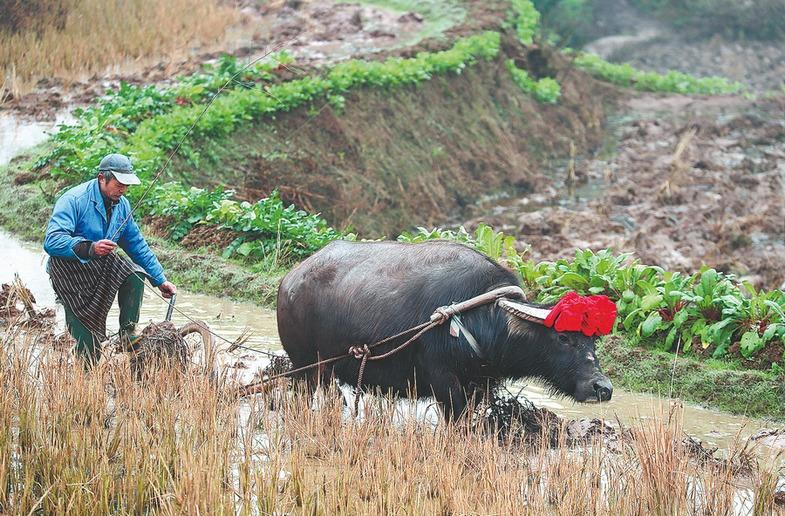 Farmers in Sichuan province celebrate the arrival of spring by using cow-pulled plows. (PHOTO / CHINA DAILY)
Farmers in Sichuan province celebrate the arrival of spring by using cow-pulled plows. (PHOTO / CHINA DAILY)
Custom lives on
With the development of the times, such activities are no longer as well observed as they were in ancient times, but "biting spring" is a custom that has been followed to this day.
The great Tang Dynasty (618-907) poet Du Fu wrote: "It's lichun today, I suddenly remembered the peaceful years. At that time, the two capitals were at their peak. Every time on lichun, high-ranking families put green silky cut chives on white jade plates, and gave them to each other through their delicate hands, so as to enjoy the festival."
The northerners pay great attention to eating spring pancakes and spring rolls on lichun. On this day, spring pancake shops in cities and villages can expect a crowd from early in the morning.
ALSO READ: Drones, data saving seeding season
The paper-thin spring rolls, wrapped around fried vegetables such as bean sprouts, leek, celery, shredded potatoes and vermicelli, as well as shredded pork with sweet and sour sauce, deliver a salty, thorny, fragrant flavor that seems to burst on the tongue.
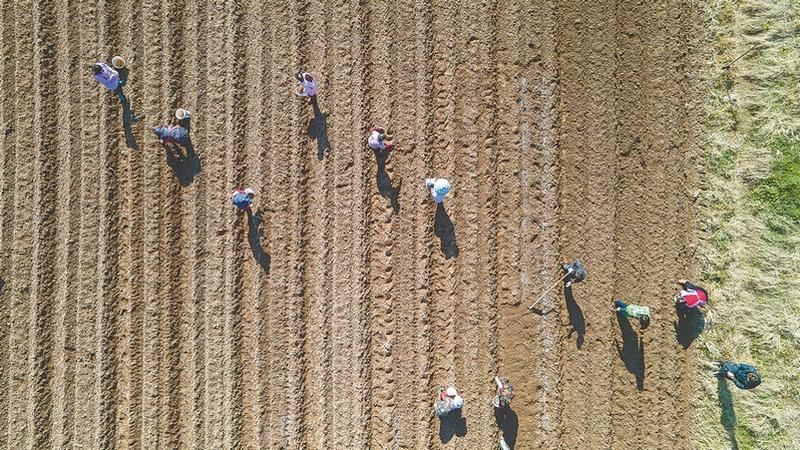 Seeding takes place in the fields of Jinhua, Zhejiang province. (PHOTO / CHINA DAILY)
Seeding takes place in the fields of Jinhua, Zhejiang province. (PHOTO / CHINA DAILY)
Crops flourish
Hardworking housewives also start work early in the morning. The chewy spring pancakes, delicious side dishes and the steam wafting from the kitchen attest to the exuberant festive mood.
It is believed that eating spring pancakes, and various vegetables contained within, will make the crops flourish and the animals thrive. Eating spring pancakes will make people work harder and live longer.
Some folks are particular about eating radish on lichun. In old Beijing, everyone wanted a "bite" of the spring on this day.
Early in the morning, street vendors would carry a trolley and yell in the alleys: "Radish is better than pears'.' At that time, no matter how poor the families were, people would buy a radish for their children to chew on.
READ MORE: Tradition and transformation ensure cultural harvest
The radishes sold in Beijing are the delicious rose heart kind — green on the outside and purple-red on the inside that have been stored for a whole winter.
People used to divide the 15 days of lichun into three periods based on folk observation: During the first five days, the east wind brings warmth and the earth begins to thaw; the next five days sees dormant insects slowly wake up; during the last period, the ice in the river begins to melt and fish come to the surface.
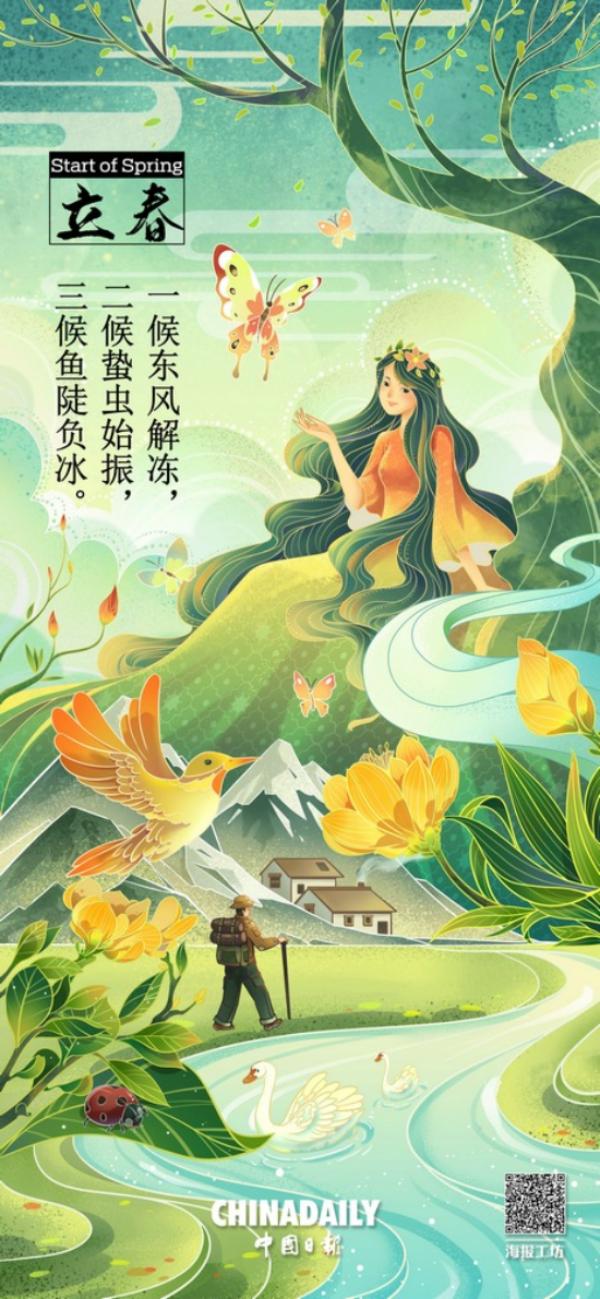 Lichun (ZHAO CHENYAN / XINGWEI / CHINA DAILY)
Lichun (ZHAO CHENYAN / XINGWEI / CHINA DAILY)
Since hopes for a good start in spring are a priority, there are special taboos observed to this day: One can't lie down on lichun, because this day is a time when the yang energy starts to rise significantly, and one should stand or sit to welcome it. There should be no verbal disputes, and one should be peaceful. One should avoid seeing a doctor, and avoid haircuts or relocation.
Folklore expert Gao Wei argues that modern people's seasonal cognition has been sabotaged, in addition to the obvious departure from the rhythm of life in an agricultural society. The failure to correctly understand the connotations of the solar terms is among the many disappointing facets of modern society.
"An often heard misconception is that 'the solar term is a climate phenomenon in the Yellow River Basin, and has nothing to do with my region'. This is only half true," he says.
"The name of the solar terms was indeed formed in the basin. However, their connotations are far more diverse than the fixed names and locations," he says.
READ MORE: Tuning into tradition
Xiao Fang, vice-president of the Chinese Folklore Society, however, is happy to see a rising national consciousness of the ancient wisdom.
He recalls that lichun was specially mentioned at the opening ceremony of the Beijing Winter Olympics last year as a symbol of growth, strength and hope. The Twenty-Four Solar Terms, representative of the intangible cultural heritage of mankind, were used as the countdown to the start of the Games, while highlighting Chinese civilization.
"Chinese people regard natural time as the basis of lifetime, which reflects an ecological wisdom of harmony between man and nature. As the head of the four seasons, lichun is a new starting point and a sign of the arrival of spring," he says.


